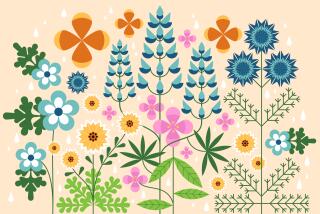How to Plant Wildflowers
- Share via
If you are planting in an existing flower bed, all you have to do is lightly cultivate the soil before broadcasting wildflower seeds. If you want to plant in an area when there are already annual grasses, lawn, or weeds, on the other hand, you’ll have to remove them first to give the wildflower seedlings a fighting chance to get established.
Once you have your site stripped of weeds and grass and cultivated, you’re ready to sow. Since many wildflower seeds are minuscule and hard to handle, you may want to mix the seeds with sand or a fine-textured potting soil, in a ratio of 2 parts medium, 1 part seed, before sowing for more even distribution. You could also separate the larger seeds from the small ones with a sieve and scatter them first.
When you’re finished, rake lightly to incorporate the seeds into the top-inch or so of soil. Or just scuff up the surface a little with your feet--a technique farmers used to call “walking in.” Add a light topping of composted organic mulch--no more than 1/8-inch--to keep seeds in place, discourage birds and maintain moisture.
Optimum planting time is Nov. 15 through March 15, according to Tree of Life Nursery, and just before an anticipated rain.
If no rain comes, simulate it. Horticulturist Kevin Connelly, author of the “Gardener’s Guide to California Wildflowers” (available for $12.95 through the Theodore Payne Foundation), suggests waiting for a cool, overcast day to seed, then gently but thoroughly soaking the seeded area over a period of several days, in imitation of the area’s typical winter storm pattern.
Once seeds begin germinating, irrigate only when the soil dries to a depth of approximately 2 inches. Once plants begin to flower, even less irrigation is needed--only an occasional dowsing to extend the blooming season.
Finally, resist the urge to remove flowers that have passed their prime. The more flowers you let go to seed, the better crop you’ll have next year.





